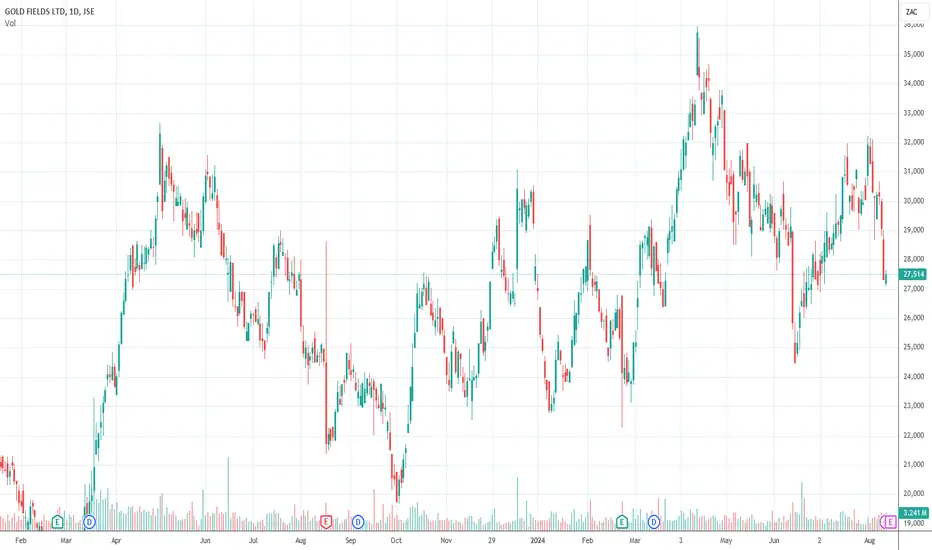Gold Fields (GFI) is a relatively high-cost international gold mining house with a single mine in South Africa—South Deep. South Deep was bought by Gold Fields in 2006, and it has struggled to make the mine profitable, pouring in a total of R32bn (R22bn purchase price plus R10bn in development costs) into it over the past 14 years. Brett Kebble once described South Deep as "the world's most expensive long drop." South Deep is 3 kilometers deep and a very difficult mine with many technical complications, but it is the second largest unmined gold resource in the world—hence Gold Field's persistence.
Gold Fields is working with an independent power producer (IPP) to build a 50MW project in South Africa. The company has spent a total of $502m over the past two years to ensure that Damang and Gruyere (international operations) would produce 2 million ounces a year for the next ten years. South Deep now has R800m less in costs and R400m less in capital expenditure. The company is focusing on bringing the new Salares Norte gold mine in Chile into production. On 11th July 2022, the company said that it would list on the Toronto Stock Exchange and that it would adopt a dividend policy of paying between 30% and 45% of profits out.
Its protracted investment in South Deep is definitely beginning to pay off, with output expected to rise by about 25% over the next four years. In its results for the year to 31st December 2023, the company reported headline earnings per share (HEPS) of 94c (US) compared with 119c in the previous period. The average rand/US dollar exchange rate weakened by 13%, and the company's debt increased by $320m to $1024m.
In an update on the first quarter of 2024 ending on 31st March 2024, the company reported 464,000 ounces of attributable production with an all-in sustaining cost of $1738 per ounce. The company said, "Production for the quarter was severely impacted by weather-related events and operational challenges, particularly at the Gruyere, St Ives, South Deep, and Cerro Corona mines, resulting in group attributable equivalent gold production (excluding Asanko) for the quarter being 18% lower year on year (YoY) and 22% lower quarter on quarter."
In a trading statement for the six months to 30th June 2024, the company estimated that HEPS would fall by between 25% and 33%. The company said, "Gold volumes sold are expected to improve in the second half of 2024 with the ramp-up of Salares Norte and production improvements at the Gruyere, St Ives, and South Deep mines." On 12th August 2024, the company announced that it had acquired the remaining 50% of Osisko Mining for $1.57bn (R29bn).
Technically, the share is very volatile and subject to shifts in the international price of gold, but it has been in an upward trend over the past five years. It remains a volatile commodity play.
Gold Fields is working with an independent power producer (IPP) to build a 50MW project in South Africa. The company has spent a total of $502m over the past two years to ensure that Damang and Gruyere (international operations) would produce 2 million ounces a year for the next ten years. South Deep now has R800m less in costs and R400m less in capital expenditure. The company is focusing on bringing the new Salares Norte gold mine in Chile into production. On 11th July 2022, the company said that it would list on the Toronto Stock Exchange and that it would adopt a dividend policy of paying between 30% and 45% of profits out.
Its protracted investment in South Deep is definitely beginning to pay off, with output expected to rise by about 25% over the next four years. In its results for the year to 31st December 2023, the company reported headline earnings per share (HEPS) of 94c (US) compared with 119c in the previous period. The average rand/US dollar exchange rate weakened by 13%, and the company's debt increased by $320m to $1024m.
In an update on the first quarter of 2024 ending on 31st March 2024, the company reported 464,000 ounces of attributable production with an all-in sustaining cost of $1738 per ounce. The company said, "Production for the quarter was severely impacted by weather-related events and operational challenges, particularly at the Gruyere, St Ives, South Deep, and Cerro Corona mines, resulting in group attributable equivalent gold production (excluding Asanko) for the quarter being 18% lower year on year (YoY) and 22% lower quarter on quarter."
In a trading statement for the six months to 30th June 2024, the company estimated that HEPS would fall by between 25% and 33%. The company said, "Gold volumes sold are expected to improve in the second half of 2024 with the ramp-up of Salares Norte and production improvements at the Gruyere, St Ives, and South Deep mines." On 12th August 2024, the company announced that it had acquired the remaining 50% of Osisko Mining for $1.57bn (R29bn).
Technically, the share is very volatile and subject to shifts in the international price of gold, but it has been in an upward trend over the past five years. It remains a volatile commodity play.
Disclaimer
The information and publications are not meant to be, and do not constitute, financial, investment, trading, or other types of advice or recommendations supplied or endorsed by TradingView. Read more in the Terms of Use.
Disclaimer
The information and publications are not meant to be, and do not constitute, financial, investment, trading, or other types of advice or recommendations supplied or endorsed by TradingView. Read more in the Terms of Use.
